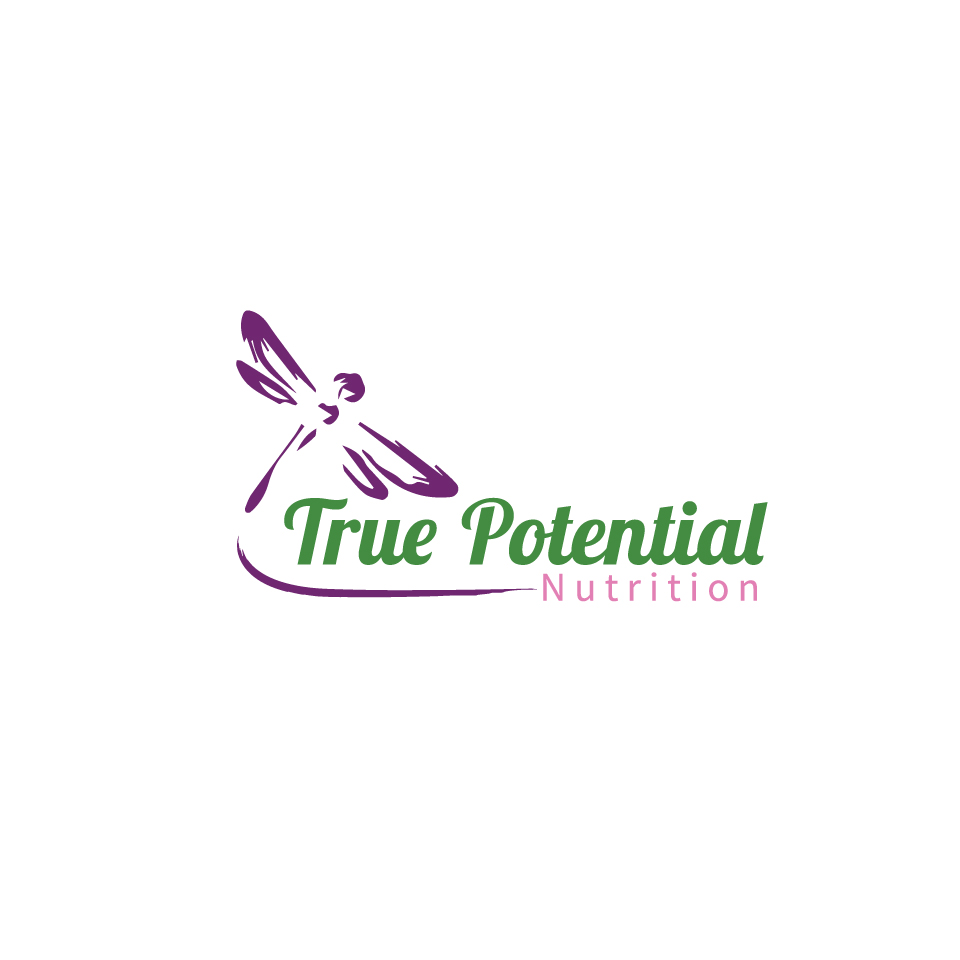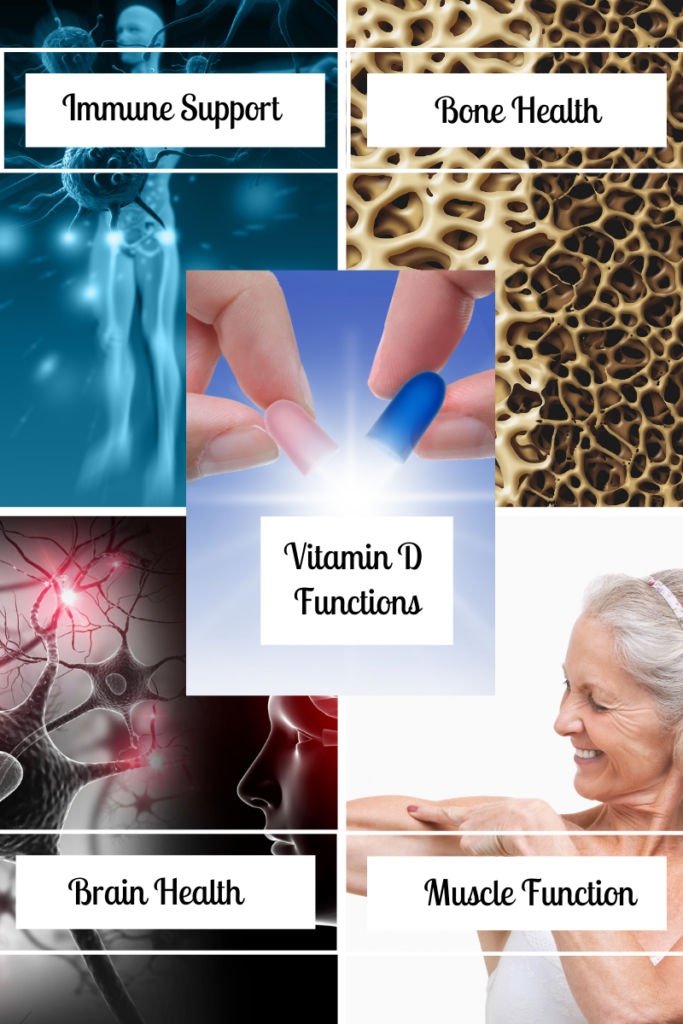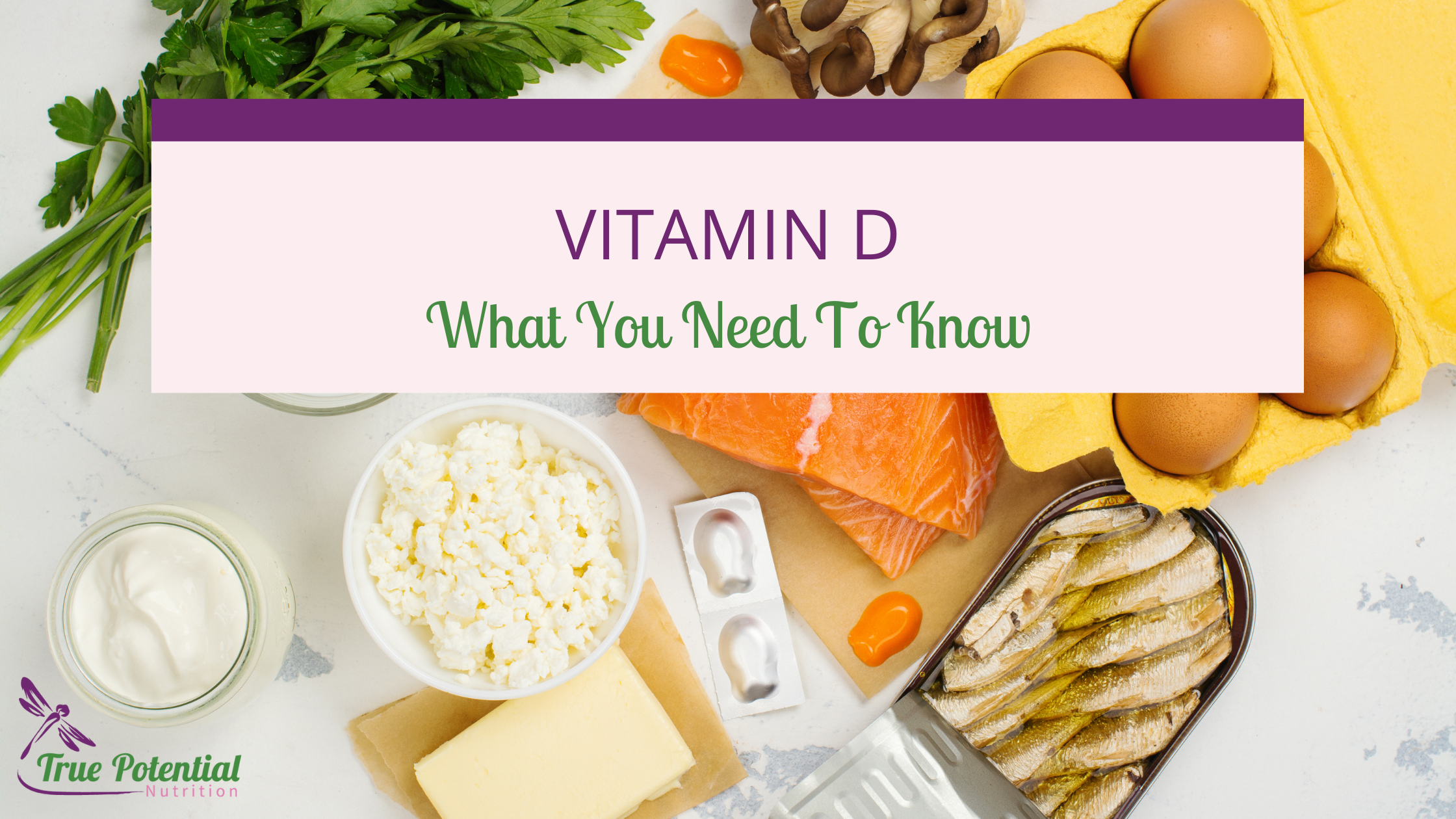By Danielle MacDowell

Main Takeaways
- Vitamin D can be obtained through fatty fish, eggs, shiitake mushrooms, fortified dairy and grains, beef liver, and the sun.
- The body absorbs sun-derived vitamin D by a steroid in the skin, which is made from cholesterol. Once absorbed, it travels through the bloodstream, to the liver and then to the kidneys. It is in the kidneys where it gets converted into its active form and can begin to perform all of its necessary functions in the body.
- The time of day, season, age, latitude, altitude, cloud cover, skin pigmentation, air pollution, weight, and sunscreen usage are important variables that determine how much vitamin D you are actually absorbing into your body and converting for use.
- Individuals who are at risk of skin cancer should look to supplementation rather than solely relying on the sun as a source of vitamin D.
- Vitamin D plays an essential role in calcium and phosphorus homeostasis, bone maintenance, immune function, and muscle function. It may even be protective against certain diseases and play a role in brain development and gene regulation.
- According to most medical practitioners, a healthy reference point is between 30-60 ng/mL. However, in the functional world, some practitioners will recommend maintaining levels between 50-80 ng/mL.
- The recommended daily allowance (RDA) is dependent upon age, but many believe that the RDA is too low.
- Vitamin D toxicity can occur, especially with intake of 10,000 IU or higher.
Table of Contents
Vitamin D: Where Does it Come From?
As a homegrown northeasterner, I lavish in the sunshine during the spring and summer months. After a long, dark winter, I am especially keen on absorbing as much vitamin D as humanly possible. You see, vitamin D is difficult to obtain from foods. Yes, you can get some vitamin D from fatty fish, eggs, and shiitake mushrooms but this is not the makings of a typical American diet. Ah yes, and for those of you who are feeling adventurous, you can always obtain some vitamin D from beef liver…but I am guessing this is not many of you. Fortunately, for us less adventurous souls, there are additional ways of getting our vitamin D. The sun, supplements, and fortified foods all provide us with alternative or supplemental ways to get the highly sought after vitamin D.
Vitamin D can be obtained through fatty fish, eggs, shiitake mushrooms, fortified dairy and grains, beef liver, and the sun.
How Our Body Synthesizes Vitamin D from the Sun
When possible, my personal preference is to get vitamin D from the most natural source, the sun. However, obtaining vitamin D from the sun is not as simple as just absorbing ultraviolet B (UVB) photons. It involves an elaborate process of synthesizing pre-vitamin D, forming D3, and then activating D3.
Acquiring vitamin D from the sun begins when our skin absorbs UVB photons produced by the sun. Once these UVB rays penetrate our skin, a cholesterol-containing steroid, 7-dehydrocholesterol, takes over and creates vitamin D’s precursor, previtamin D3 (precholecalciferol). Our body then rearranges the infrastucture of previtamin D3 to form a more stable structure, vitamin D3 (cholecalciferol). You are probably familiar with vitamin D3 because this is what you will find in many vitamin D supplements.
The vitamin D conversion process is not complete until it undergoes another series of steps to activate vitamin D. After vitamin D3 is created, it travels through the bloodstream, to the liver and then to the kidneys. It is in the kidneys where vitamin D gets converted into its active form, calcitriol (otherwise known as 1,25 dihydroxycholecalciferol). From here, calcitriol is able to fulfill its many integral roles within the body.
Obtaining vitamin D from the sun is not as simple as just absorbing ultraviolet B (UVB) photons. It involves an elaborate process of synthesizing pre-vitamin D, forming D3, and then activating D3.
In some respects, getting vitamin D from the sun may seem straightforward. However, it is not as simple as merely stepping outside on a sunny day. The time of day, season, your age, latitude, altitude, cloud cover, skin pigmentation, air pollution, weight, and sunscreen usage are important variables that determine how much vitamin D you are actually absorbing into your body and converting for use.
Some experts will argue that in order for you to obtain adequate vitamin D, you must sunbathe naked outside for 30 minutes. Some professionals even take it a step further and recommend forgoing a shower afterward to avoid “washing off” the vitamin D. While your body may enjoy this experience, your neighbors may not take too kindly to it!
Fortunately, there are alternatives (or adjuncts) to naturally acquiring vitamin D if spending time outside in your birthday suit is not an option.
It is also important to note that sun exposure is not an option for many people due to the risk of skin cancer. In instances where adequate sun exposure is not an option, supplementation might be considered as part of a daily dietary regimen.
The time of day, season, age, latitude, altitude, cloud cover, skin pigmentation, air pollution, weight, and sunscreen usage are important variables that determine how much vitamin D you are actually absorbing into your body and converting for use. Individuals who are at risk of skin cancer should look to supplementation rather than solely relying on the sun as a source of vitamin D.
Benefits of Vitamin D
Vitamin D is associated with several functions. Because of its influence on genes, it is even considered by many in the field of nutrition to be a hormone rather than a vitamin. Gropper [1] highlights many of the primary functions of vitamin D.
Calcium Homeostasis: Calcitriol, the active form of vitamin D, increases calcium absorption in the intestines, reabsorption in the kidneys, and calcium resorption in the bone when calcium levels are low. Calcium is an indispensable and irreplaceable mineral in our body, as it plays a vital role in bone maintenance, muscle function, and nervous system functioning.
Phosphorus Homeostasis: Similar to its response to low calcium, when phosphorus is low, vitamin D increases phosphorus absorption in the intestines and resorption in the bones to restore healthy serum phosphorus levels. Phosphorus is a vital mineral. It is integral in a number of structures within in our body, including our bones and cell membranes. But, it doesn’t stop there, phosphorus is also part of our DNA, RNA, and ATP, so its necessary for genetic coding and energy production. All this to say, vitamin D is essential in keeping these structures intact and working properly.
Bone maintenance: Not only does vitamin D play an indirect role in bone maintenance by facilitating calcium and phosphorus homeostasis, but vitamin D also plays an integral role in the generation of specialized bone cells called osteoclasts; these cells are responsible for bone repair, remodeling, rebuilding.
Muscle function: Vitamin D increases calcium uptake in cells, which is necessary for muscle contraction. It also plays a role in the generation of muscle tissue. Because of its role in muscle health, when individuals have inadequate vitamin D levels, they may experience muscle weakness and pain.
Immune function: Sufficient levels of Vitamin D are necessary for the production of macrophages and monocytes, two cells heavily involved in our immune system. This is an especially important consideration during times of the year when viruses are running rampant.
Possible Disease Protection: Although correlation does not equate to causation, it is worth noting that a number of diseases have been correlated with vitamin D deficiency in recent research literature, including hypertension, type 2 diabetes, autoimmune disease, inflammation, and cancer.[1]
Brain Health & Genetics: Vitamin D has also been shown to play a role in aging, neurodevelopment, brain homeostasis, and gene regulation. [2] There is also preliminary evidence suggesting it may play a role in the genesis of autism spectrum disorder (ASD) and autism-associated behaviors.

Vitamin D: Vitamin D Testing, RDA, & Toxicity
Vitamin D Testing
At this point you may be wondering about your personal vitamin D levels. Fortunately, there is a way to determine this via a blood test.
There are two types of vitamin D tests:
- 25-hydroxy-vitamin D (most common and accurate test)
- 1,25-hydroxy-vitamin D (active form of vitamin D)
25-hydroxy-vitamin D (25(OH)D): When speaking about vitamin D tests, practitioners are often speaking about 25-hydroxy-vitamin D, which is the most accurate vitamin D test. Reference ranges are typically based on nanograms/milliliters. However, it is important to note that they could also be based on nanomol/Liters. So, when determining if you are within healthy limits, make sure you are basing your information off of the correct units. It can be an easy thing to overlook!
25(OH)D Reference Range: According to most conventional medical practitioners, a healthy reference range for 25(OH)D is between 30-60 ng/mL. In the functional world, many practitioners will recommend maintaining levels between 50-80 ng/mL.
1,25-hydroxy-vitamin D: You are likely wondering when this test would be used. As mentioned above, this test essentially assesses our body’s ability to convert vitamin D to its active form. So, if someone has normal 25(OH)D but has signs of vitamin D deficiency (e.g. elevated parathyroid hormone, low calcium), this test may be used. Remember, this conversion occurs in the kidneys, so proper kidney functioning is essential to vitamin D health. In addition to kidney functioning, it is also critical to have the proper nutrients to facilitate this conversion.
Recommended Daily Intake: Similar to the reference ranges, the recommendations on daily intake is also a hotly debated topic. That being said, there is a recommended daily allowance (RDA), which has been established by the Food and Nutrition Board and can be found below.
Recommended Daily Allowance for Vitamin D:
- Infants (0-1 yrs.old): 400 IU/day
- Children and Adults (1-70): 600 IU/day
- Elderly Adults (70 plus): 800 IU/day
If you have dipped your toe in the alternative medicine world, the recommended daily allowances seen above may seem quite low. I don’t know about you, but I have heard many people speak about taking between 5,000 IU/day-10,000 IU/day, which contradicts the tolerable upper intake level of 4,000 IU/day.
So, when it comes to recommended daily intake for vitamin D, how do you decide between utilizing the RDA or basing it on alternative recommendations?
With all of the contradicting advice and evidence out there, it is tough to answer this question. As a general rule of thumb, if you are considering taking supplements higher than the RDA, it is always important to speak with your health care practitioner beforehand. This is especially true for iron and fat-soluble vitamins. Due to the way the body stores these nutrients, toxicity can occur and subsequent problems can arise.
Vitamin D Toxicity
Vitamin toxicity occurs when there is too much of a particular vitamin in the body. For this reason, there are established tolerable upper limits (UL), or a maximum daily dosage, for many vitamins.
The UL for vitamin D is 4000 IU (100 mcg). Remember, for many of us, vitamin D is generated from the sun. So, if you are considering supplementation, this needs to be accounted for when determining the dosage.
Word of Caution: People with liver or kidney conditions are particularly susceptible to having a negative reaction to higher doses of vitamin D.
Final Thoughts and Main Takeaways
Vitamin D is a superstar in the vitamin world and is finally beginning to get the recognition it deserves. In my opinion, we are just beginning to scratch the surface when understanding the full capability of vitamin D within our body. I think that many of us can agree that what we do know is quite astounding!
Stay tuned for future blogs on vitamin D and its impact on the human body.
1. Gropper, S, Smith, J, Carr, T. Advanced Nutrition and Human Metabolism. 7th Edition. Boston, MA: Cengage; 2018.
2. Saad K, Abdel-Rahman AA, Elserogy YM, et al. Vitamin D status in autism spectrum disorders and the efficacy of vitamin D supplementation in autistic children. Nutr Neurosci. 2016;19(8):346-351. doi:10.1179/1476830515Y.0000000019





